New cars
EV Revolution

Let’s ditch fossil fuels and crude oil for a while, since some say that oil is considered environmentally unclean and unfit for burning. So, what about electric? Which of our earth’s finite resources are needed to make electric vehicles (EVs)? It will be Tanzania, Venezuela, the Democratic Republic of Congo, Canada or even Brazil who could be the providing the rest of the world with precious raw metals that the greener EV requires.
As electric cars appear to be going mainstream and all our main automotive manufactures look to ditch internal combustion engines (ICEs) by 2025-ish, these big automotive giants have to source and make investments into electric cars and their necessary componentry. Countries like South Africa, Tanzania, China and even Australia have very mineral-rich and rare metal resources. These countries and their mining industries are the world’s best environmentally friendly strategy to power EVs and their mass production.
There is a global race on that is driving the demand for countries, including quite a few in Africa, to mine as much of their precious metal resources to equip the world with a greener fleet of vehicles. This clambering for sourcing all the right stuff for EV production en masse could soon provide billions of dollars into certain countries’ GDP rates.
Rare metals like copper, lithium, cobalt and nickel are some of the most discussed metals in EV production demands. Other metals like neodymium (a rare earth metal), aluminium and zinc have emerged as some other new resources that will be needed in the rapid quest for a greener world. Statista, a German company specializing in market and consumer data, estimates that the demand for metals such as nickel, aluminium, and iron (all the critical components in EVs) will jump to as much as 14 times the rate that it is now by 2030. This huge demand for environmentally friendly EV minerals for meeting the green EV car revolution will provide a great cash injection for a well-endowed African state. Demand for metals like lithium and graphite are also expected to rise substantially, even by as much as 9-10 times by 2030.
The large estimated increase (14x) in demand for the clean EV minerals to meet the intended global EV production rates over the next ten years is accompanied by the need for vehicle battery outputs and infrastructure, which are expected to rise by millions of times over in the very near future. Even Toyota recently announced a 13.6 billion US investment into electric cars and hybrids, with some 9 billion US dollars to be spent on battery production alone. This is fantastic news for the environment and carbon zero.
The increase in demand for these rare and hard to obtain metals is pushing top mining and big investment companies around the globe to invest in the acquisition of key materials used in the production of EV batteries, EVs themselves, and their much needed electrical infrastructure. Solar energy componentry, as well as the EV requirements, all point towards an enormous boom in demand for these rare and hard to reach resources, as well as creating an opportunity to make even more money than the awful and “dirty” fossil fuel endeavours.
It is expected that the sales and production of EVs will continue to accelerate quickly over the next five years. Big automotive giants who are changing to larger-scale EV production have major mining countries like South Africa, Namibia, the Democratic Republic of Congo (DRC), Tanzania, Zimbabwe and Botswana on their radar. These are just some of the main African countries, let alone other countries around the world, who enjoy bountiful reserves of some of the world’s most precious metals and minerals: minerals such as gold, diamond, cobalt, iron ore, coal, and copper. Meeting the demands by governing authorities and their growing appetite for better and greener EVs will be much better for the environment – and for special places like Africa, I’m sure.
President Hakainde Hichilema is the new president for Zambia, and he has recently announced plans to ramp up mining in particular, and to jump-start Zambia’s economy. Part of his economic plan provides for the rapidly growing EV battery industry, with cobalt and copper identified as key components. The workforce will be a great place for young men from the age of 15 years old, who will be able to work in the dangerous mining industry. Countries like Zambia and Tanzania are working hard to supply the developed countries of the world with the rare metals. The developed countries are considered to have a higher status and economic standing, a better understanding of the environment, human ethics, health and emission standards. Their demand for a green EV world is a good thing for all people and the environment.
As the big green machine, Tesla, and auto giant Toyota are joined by other larger EV-producing manufacturers, African mining countries are going to have to move faster than ever to meet the demand put on them by the governing authorities of the world and their ever-increasing and severe carbon emission goals and standards. The president of Zambia, Mr. Hichilema, has wasted no time in announcing his administration’s hopes to quickly provide the clean EV battery supply chain and invest much of his country’s proceeds into its development.
Rare metals and their difficult and extensive underground extraction methods are needed in EV lithium ion battery technology and are critical for improving the driving range of electric vehicles so that they can compete with the best, most frugal, “archaic” ICE technology and emission-capturing methods. These rare metals are buried beneath the fields of African nations, ready to be harvested by economically sound, rich and developed countries with zero carbon emission goals and standards.
South Africa, a mining giant, has also announced plans to set up production plants to manufacture EVs of their own, including plants for the manufacture of EV components, such as EV batteries. This could see South Africa as one of the multi-billion-dollar raw material producers of the world. South Africa already has its raw material extraction industry, its capital markets, and its existing manufacturing and export infrastructure to build upon.
Environmentally friendly keywords that current governments, economists and greenies around the world are sharing with the public are words like carbon emissions, climate change, EVs, EV infrastructure, mining, metals, zero carbon, clean technology, investment and climate crisis. All of these keywords correspond with the rising demand for the precious metals used in EV production.
As it stood in 2020, the total global nickel reserves amounted to approximately 94 million metric tons. Of that amount, it was Indonesia that held the world’s largest share. Following the tropical and beautiful Indonesia is Australia, with our nickel reserves estimated to be 20 million metric tons. Best we get stuck in, then!
Most Reliable Cars in 2021
How reliable a car is directly correlates with our ownership satisfaction rating, right? So, if we own a car that is always needing something fixed or repaired to make it properly functional, our contentment levels will be lower than if our car was reliable all or at least most of the time. It won’t take long for an unreliable car to start to irk us. Reliability is always a black and white area when it comes to car ownership satisfaction.
What car? has recently published their survey findings for 2021. They questioned more than 16,000 people across the UK who owned a car no older than 5 years old, and this is the results that show which cars and brands are the most reliable, and which ones are not. Is it possible that the more reliable a car is, the more green and sustainable the car is?
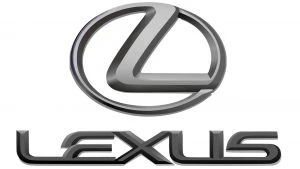
First place goes to Lexus who claims the top spot as the most dependable brand of car you can buy. Lexus cars suffer from very few faults. The Lexus NX SUV is the highest-rated hybrid you can buy.

Second place brand is Dacia, which is considered to be a budget brand. Here is a prime example of reliability and low cost going hand in hand. Dacia’s star performer is the previous generation Dacia Sandero.
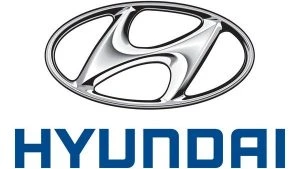
Hyundai takes the bronze, where the previous generation Hyundai i10, the larger i20, and the current Hyundai i30 being standouts. It was revealed that the problem areas included the brakes and gearbox, however the brand’s 5-year unlimited km warranty meant that most problems were fixed for free.
Suzuki
Suzuki takes fourth place for brand reliability; an excellent result. The little Suzuki Swift is the third most reliable car – a star performer for Suzuki.
Mini
Mini cars are generally pretty reliable cars. Mini’s Countryman scored well in the small SUV class. Mini’s little Hatchback is the sixth most reliable small car overall – a great result.
Toyota
Toyota has long been an impressively reliable brand, though it’s slipped slightly from third place last year.
Mitsubishi
Mitsubishi ranked 7th, their place unchanged from last year. The Mitsubishi Eclipse Cross is the most reliable family SUV on the market, boasting a 100% reliability score!
Mazda
Eighth place goes to the Mazda brand. Mazda highlights include the CX-3 (a very reliable small SUV), the CX-5 (petrol version), and the MX-5 sports car.
Kia
Star performers for Kia are the XCeed and Ceed family cars, which are among the most reliable in their class, while the Kia Optima is the second-most reliable executive car. Kia’s affordable E-Niro is the third most reliable EV.
MG
MG is the brand that takes out 10th spot. The classy MG ZS EV is the second-most reliable EV in the survey.
11) Citroen – Citroen’s C3 Aircross is the third most reliable small SUV.
12) Skoda – Skoda’s Superb is the most reliable executive car.
13) BMW – BMW’s previous model 1 Series is the most reliable family car. The BMW 5 Series is the most reliable luxury car. The BMW 3 Series also ranks 3rd in the executive class. Current BMW Hybrids are not quite so reliable.
14) Honda – The previous model Jazz was fifth in its class, while the HR-V is the most reliable small SUV.
15) Tesla – the Tesla Model 3 ranked 5th in the EV class.
16) Renault
17) Seat
18) Audi – Audi’s TT is the number one sports car for reliability.
19) Volvo
20) Volkswagen
Jaguar, Mercedes Benz, Peugeot, Vauxhall, Porsche, Alfa Romeo, Ford, Nissan, Land Rover, and then Fiat takes out 30th spot.
Of the last 10:
Porshce’s Macan took 1st place for the luxury SUV class.
Nissan’s LEAF is 1st for the most reliable EV.
Honda’s Latest
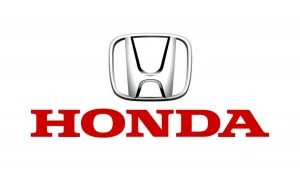
As with many other automotive manufacturers, Honda is on the hunt for having its fleet become fully electrified. Honda’s vision is to have 100% of its new vehicles with zero emissions by 2040. There are some neat EV models in the pipeline, but also some vehicles that help transition the gap from petrol to hybrid to 100% electric. Honda’s 2022 Civic models are set to be enjoyable.
Honda recently announced that their Prologue SUV, which will be Honda’s first new EV sold in big volume, will be a battery-electric vehicle (BEV) that will go on sale in 2024. It is likely that the Prologue SUV will be an American-only seller first, so how that fits in with Australia remains to be seen. As EV infrastructure expands, and customer interest grows nationwide and globally, the company will expand sales and marketing efforts accordingly. Following the launch of the Honda Prologue, the company will create additional EVs based on the new e-Architecture that is currently being developed and customer demand.
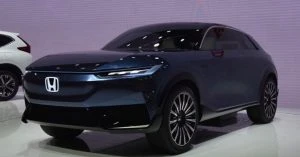
Honda Prologue SUV
Honda has a long history of being a leader in creating hybrid and electrified vehicles. Honda’s Insight still is a very good example of how a hybrid should perform, and it remains a strong seller with people who are looking for low emissions and frugality in fuel usage. As Honda prepares for the launch of the Honda Prologue for America, the company will introduce hybrid-electric systems to other core models to continue to reduce CO2 emissions while helping create a bridge for customers to move from fossil fuels to hybrid to EVs.
Honda’s management have stated that they are aware that customers who have a good experience with a hybrid vehicle are more likely to buy an electric vehicle in the future. We can see that their hybrid sales have increased over the last few years. Led by models such as the CR-V Hybrid and the Accord Hybrid, Honda just recorded its best-ever first-half year of electrified vehicle sales. The Insight has also sold well.
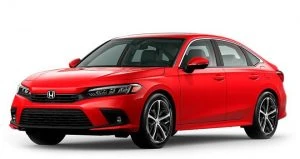
2022 Honda Civic Sedan
Now what about now? Let’s take a look at the all-new Honda Civic Hatchback! In 2022, Honda will be selling the latest Civic in Australia. The car is aimed predominantly at young buyers who are captured by its fastback design and sporty driving character. The new Civic will offer a slick-shifting 6-speed manual transmission as well as an automatic CVT option to go with the 2.0-liter normally aspirated motor or the 1.5-liter turbo engine. High-performance Si and Type R models are to be available, and they are cars I’ll be keeping my eyes out for.
The largest back seat to ever be inside a Civic Hatchback comes with 2022 models, and the cars also features new standards of safety technologies. All 2022 Honda Civic Hatchbacks include Honda’s new next-gen driver and front passenger airbags and an expanded Honda Sensing suite of driver-assistive and safety technology that adds Traffic Jam Assist and a smoother, more natural feeling to functions like Adaptive Cruise Control (ACC) and the Lane Keeping Assist System (LKAS). It will also include Collision Mitigation Braking System (CMBS) with Pedestrian Detection, Forward Collision Warning, and Road Departure Mitigation (RDM).
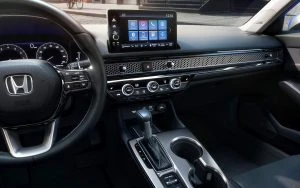
2022 Honda Civic Dash
2022 Honda Civic EX-L models will boast all the luxury features, so big color touchscreen with Apple CarPlay and Android Auto integration, push-button start, partial digital instrumentation, blind-spot information (BSI), leather upholstery, an 8-way power driver’s seat, heated front seats, heated outside mirrors, a one-touch power sliding moonroof, dual-zone automatic climate control and LED headlights are the go.
Sportier Civics will have racy looks thanks to things like a short shifting 6-speed manual transmission (or CVT), Berlina Black 18-inch wheels, low-profile 235/40R-18 tyres, black exterior accents, an 8-speaker audio system, sport-specific upholstery, a leather-wrapped shifter and steering wheel, paddle shifters (CVT only) and sport pedals.
As the automaker prepares for the launch of the Prologue SUV in America, expect to see more hybrid variants of current core models to ease the transition to full electrification.
Ford Movements
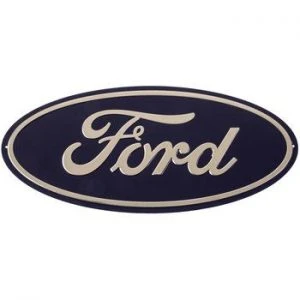
Hot off the Press News has Ford investing big money in EV production. All up, Ford and a South Korean supplier will spend $11.4 billion US on Ford’s EV production and expansion. Ford hopes this spend will enable them to produce more than one million EVs per year in the second half of this decade. The buzz words used in new and future cars include the term electric vehicles or EVs. Established automakers like Ford are racing to try and close the gap on Tesla’s EV lead. As you may be aware, Tesla produces a range of EVs, and Tesla are currently on the way to selling more than 800,000 electric cars this year. Tesla is currently the most valuable automaker in the world, with a market capitalization of nearly $800 billion US. Ford’s market value is $56 billion US.

Ford F-150 Lightening
Ford’s big spend will be its 2nd biggest spend in its history. Under the climate change banner and the Biden government, this latest US multibillion-dollar move to quickly transfer production plants to EV production is seen as a fast track phasing out of gasoline-powered cars and trucks as part of the global push to combat climate change. I won’t debate the science here.
Ford is to build 2 battery plants in Kentucky and 1 in Tennessee under the joint venture with its main battery cell supplier, SK Innovation of South Korea. In addition, Ford will build an assembly plant at the Tennessee location to churn out EV trucks. Ford will invest $7 billion and SK Innovation $4.4 billion, the companies have said. Ford expects electric vehicle models to make up 40% of their vehicle production by 2030. That’s only a little over 8 years away!
Ford’s new truck plant and battery factory in Tennessee is likely to be the place that will produce a new battery-powered Ford F-Series pickup truck, this following the previously announced F-150 Lightning pick up truck. I have to say that the F-150 Lightening is an impressive beast! Ford has said a mix of both the public and businesses had already placed 150,000 reservations for purchasing the F-150 Lightning.
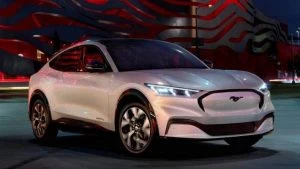
Ford Mustang Mach-E
Also this year, Ford began selling the Mustang Mach-E, which has taken a sizable market share from Tesla. Ford also plans to add an EV delivery van into the mix by the end of the year. Then, in early 2022, the electric F-150 Lightning will roll out of their showrooms and silently onto the tarmac.
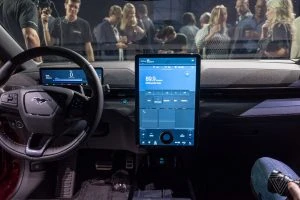
Ford Mustang Mach-E
Mr. Jim Farley, Ford Motor’s president and CEO, has recently said that making electrical vehicles affordable should be among the top priorities for automakers, so that the average vehicle-buyer can purchase one. This is good news, as a new EV is well out of most people’s budget.
He also made a couple of rather poignant comments: one on a key issue on questioning how EV production will impact labour/jobs (a subject rather close to home with our relatively recent Ford and Holden closures), and the other on materials. So, apparently, it costs 30% less to manufacture the Ford electrical vehicles. This will definitely affect production rates and employment long term. Then there is also the issue of battery supply and the rare minerals (i.e., lithium, cobalt) needed to power them, said Farley. Mr Farley stated, “We have to bring battery production here, but the supply chain has to go all the way to the mines. That’s where the real cost is, and people in the U.S. don’t want mining in their neighbourhoods. So, are we going to import lithium and pull cobalt from nation-states that have child labour and all sorts of corruption, or are we going to get serious about mining? … We have to solve these things and we don’t have much time.”
Here in Australia, we haven’t jumped on the EV wagon just yet, and if we are going too, then there is so much infrastructure that will be needed to be implemented before owning an EV becomes a viable option for people like me. Even the thought of the costs involved in getting the right infrastructure is eyewatering, and, like most impatient home renovators and idealistic politicians, the job must be done yesterday! The hard working folk pay for it, of course!
There seems little patience on offer by many governments and climate change activists for making the move to EVs (and other new transportation technology like an EV repower on your existing car) a more balanced and delicate affair. For now, owning an EV is very much for the elite, so Farley is on the right track when he says that the cost of EV ownership must be addressed very quickly.
Ford still has many plants throughout the U.S. However, like other big automotive manufacturers, Ford also has locations right around the world. Ford has many production plants scattered about the globe, and these include assembly plants, engine plants, forging plants, stamping plants and transmission plants. Here, in Australia, Ford still has special engine production and stamping plants.
On a more local note, Ford has a new feature called ‘FordPass’ offered on all their new models sold in Australia. FordPass has a few systems worthy of a mention that include:
Remote Start+, where minutes before leaving, you can start your connected vehicle’s engine from your mobile device in order to heat or cool the cabin using the last known climate control setting.
Vehicle Status, where you can check key variables such as fuel level and your odometer on the FordPass App to help plan your journey.
Remote Lock/Unlock, where, conveniently, you can use your mobile device to make sure the car doors are locked or unlocked without being anywhere near your vehicle. If only it could do that for my house front door!
Vehicle Locator, where you can check your vehicle’s exact location in the FordPass App, which is particularly useful if you share your vehicle with one or more members of your household or if you have forgotten where you parked it. However, if you’ve forgotten where you’ve parked it, then maybe you better get breath tested!
Vehicle Health Alerts, where the FordPass App sends Vehicle Health Alerts directly to your mobile device, pre-empting service needs and general maintenance such as low washer fluid.
Live Traffic, where this feature enhances your SYNC 3 Navigation system by delivering up-to-date traffic updates. This technology allows you to adjust your recommended route based on the traffic conditions, helping you to arrive more relaxed and on time.
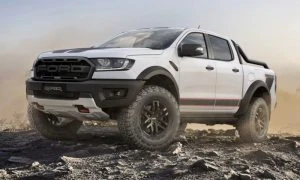
Ford Ranger Special Ediiton
In this second half of 2021, Ford Australia offer a nice broad range of vehicles that include the Puma, Escape and Everest SUVs; the Ford Focus car; the Ford Ranger Ute; the Transit Commercial range that has custom vehicles, vans, buses and cab-chassis models; the Ford Performance range that includes the Fiesta and Focus ST, the Focus ST-3, the Ranger Raptor, the Mustang and Mustang Mach-1; and the Special Edition Rangers and Everests.
It is good to see Ford keeping pace with any EV and hybrid automotive technology and movements; though at what societal and environmental cost? New Ford vehicles are good, and Ford offers a very complete package for all new vehicles in the Ford range. Once you’ve driven a Ford, its not so easy to change out of the brand come new car buying territory.